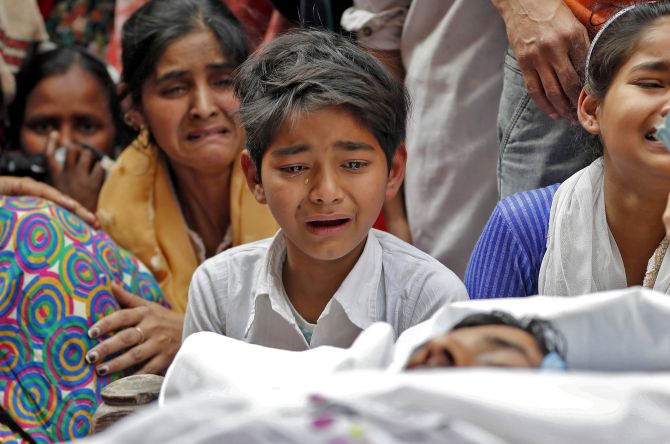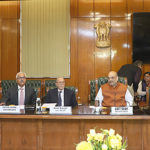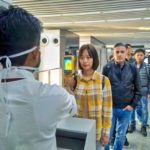‘If you look through the optics of BJP leader Kapil Mishra, he was standing with a deputy commissioner of police while giving a hate speech.’
‘Immediately, the message goes down that the police is ‘with us’, so let’s start rioting.’
IMAGE: Family members mourn Muddasir Khan who succumbed to injuries sustained during the riots in northeast Delhi, February 25, 2020. Photograph: Adnan Abidi/Reuters
Film-maker and social activist Rahul Roy worked in the relief camps for victims of the 1984 anti-Sikh riots.
As a college student, he saw from close quarters the genocide of Sikhs a day after then prime minister Indira Gandhi was assassinated by her Sikh bodyguards.
So when violence in northeast Delhi erupted this week, he quickly realised that if it was not immediately stopped, it would develop into another 1984-like situation.
Therefore he, along with other activists and civil society members, met Delhi police authorities and Deputy Chief Minister Manish Sisodia, requesting them to intervene and stop the riots.
Not getting any positive response, Roy and his friends then moved the Delhi high court.
It was his plea on which Justice S Muralidhar directed the Delhi police to ensure safe passage to injured victims and provide emergency treatment at government hospitals.
“If the police wants to stop a communal riot, it does not take more than four hours for them to do so,” Roy tells told KhabriBaba.com‘s Syed Firdaus Ashraf.
Tell us about your involvement with the victims of the Delhi riots. How did it begin, and what did you see?
When the violence started and the way it started, many of us, who have in the past seen communal riots, knew this had a potential to develop into a massive crisis.
So we immediately called a meeting of various civil society members, activists and especially people working on communal violence.
A decision was taken keeping in mind that we are probably going to face a medical crisis and the need to evacuate and help people once the violence spread.
It was clearly visible that the violence was going to spread, so we immediately set up an emergency response system and control room.
We started working on three aspects: Distress calls, distress situations and news of violence coming from different parts.
We were confirming and verifying it and giving the information to our rescue team.
This rescue team was interacting with people who were making distress calls and then trying to reach the police.
What made you move the Delhi high court?
We got desperate calls informing us about two bodies lying in the Al-Hind hospital and also about 20 people with stab wounds and bullet injuries being treated there.
This was at 4 pm. Till 11.30 pm we tried and tried to get ambulances so that these people could be evacuated.
We knocked on the doors of the Delhi police and the Delhi government, but we could not get safe passage for ambulances as they were either stopped by the police or violent mobs.
So at 11.30 pm we went to the high court, that heard our plea at midnight. The police was called at the hearing and they were ordered to provide safe passage to ambulances.
At about 3.30-4 am, we started getting ambulances and doctors at Al-Hind hospital.
Now, because of the court orders, we are getting help from the police.
We are processing the calls and informing the police as to where evacuation in needed and where violence is spreading.
You said in an interview that you went to meet the authorities, but everyone said the situation was out of hand. So whom should we blame for these riots?
It is very clear that the violence was engineered through hate speeches. Signals were given that violence can happen and no action will be taken.
That was fairly clear to anyone who knows the situation of communal violence. They can identify the signals.
If the police wants to stop a communal riot, it does not take more than four hours for them to do so.
And it was very clear that the police was not taking action, but let things simmer and the violence go on.
After three days, another signal was given through the optics of the national security advisor’s (Ajit Doval) visit (to the riot-affected areas). Then the violence started ebbing, but even now it is not completely in control.
There is not enough police force on the ground and we don’t know why paramilitary forces are not being utilised in the numbers that they should be.
They clear up some area. They go and conduct flag marches in others. And as soon as they leave, violence erupts again.
Yes, the magnitude of violence has come down and so does the number of casualties, but the situation is very tense.
On Wednesday, the people who were evacuated from the disturbed areas, their houses were looted and burnt.
How did the violence start? Was it because of Muslim women blocking the Jafrabad metro station in protest against the Citizenship (Amendment) Act? What prompted them to do so? Who brought them there?
If someone is holding a protest, is that a provocation?
It can be a provocation to the government or the State, but the protest is not against the people living in the area.
The protest is against the government and it is not for people and politicians to react. That is why I am saying it was completely engineered.
If you look through the optics of BJP leader Kapil Mishra, he was standing with a deputy commissioner of police while giving a hate speech. Immediately, the message goes down that the police is ‘with us’, so let’s start rioting.
Who ‘engineered’ these Muslim women to come and block the Jafrabad metro station? They were trying to create another Shaheen Bagh in Delhi and that is what resulted in the riots.
People are sitting on streets at 22 protest sites in Delhi. There are 24×7 dharnas happening.
Yes, Shaheen Bagh protest is happening in the middle of the road. But all other 21 protest sites are on the roadside.
You have to look from the position that in the biting cold, thousands of people sat on protests and dharnas that were peaceful.
The protest is against the government over CAA, NPR (National Population Register) and NRC (National Register of Citizens).
The people are not getting any response (from the government). There is no dialogue.
The message from the government is that do what you may, we are not going to talk with you.
In this situation, people are getting frustrated as to what do we do now? And in that frustration these decisions of blocking another road are being taken.
This is what happened at Jafrabad. Thousands of women were sitting and protesting and nothing was happening so that day, they decided to block the road. That is what transpired.
You mean that these women were already protesting near Jafrabad metro station and on that particular day they decided to block it?
Yes. Because there was some call about a Bharat bandh by the Bhim Army.
They moved only 200 yards away from where the protest was going on for the last two months, to block the metro station.
Do you think there was a deeper motive behind Sunday’s protests — to spark off violence during United States President Donald J Trump’s visit, to show the government in bad light?
Where’s the logic in sparking violence and getting killed? I can understand sparking violence to kill others whom you consider your enemies.
But you don’t spark violence to kill yourself or to get in a situation where you have to leave your house.
You have to understand that a large number of people are really frustrated with the situation. They are angry with the situation and they are living in fear of what is going to happen once the NPR process starts in April.
The thing about this movement is that there are no leaders or group of leaders.
People are taking decisions on streets and all young men and women are involved. They are taking their decisions themselves and there is no clear line of leadership.
All these (protest) sites are taking their own decisions independent of each other or where local leaders are taking a call about what to do.
It is a certain situation in which all these things are happening.
Why did you meet Manish Sisodia as Delhi’s law and order is Home Minister Amit Anilchandra Shah’s responsibility? Did you meet Shah or any other BJP leader?
We met Joint Commissioner of Police (Law & Order) Deven Srivastava but from that meeting we felt that the riots will not stop and will rather escalate.
Immediately after that, we met Manish Sisodia and sought the Delhi government to assume some role or responsibility.
But they washed their hands off saying that they are in the same situation as us.
How can a government be in the same situation as us?
Did BJP leader Kapil Mishra’s statement, that if the police not clear the protestors they will will do so in three days, add fuel to fire?
Kapil Mishra’s statement sparked the Delhi riots. These are all signals that were sent down (to rioting mobs).
And the signal was that we can do something and there will be no action taken. Anyone in the police administration knows that if they don’t want communal riots, it will not happen. Period.
If communal riots last for more than four hours, it means the administration is lax and not fulfilling its duties.
You said we were close to a 1984-like situation. Many people believe that it was a genocide as only Sikhs were targetted and killed. Here both Hindus and Muslims have died and been affected.
So how can you compare the two situations?
I said we were on the edge and we could have absolutely slipped into that situation of 1984.
I was a college student then and I worked for two months in relief camps.
I have seen the Delhi riots very closely and this riot was like re-living those three days of 1984 when there was no presence of the police.
Even when violence happened in front of policemen, they did nothing.
It was exactly like this situation.
And I don’t know whether we are still out of that situation, but at the moment things are getting better.
Right now the Muslim community is uneasy about the CAA, NPR and NRC. What kind of trust building measures should our leaders need to take to win their confidence?
The case is in the Supreme Court. There is an entire community plus many other people who are going to have a terrible time with the NPR and NRC.
The CAA, NPR and NRC have created fear and paranoia over what is going to happen. There is a complete breakdown of trust, faith and humanity.
Many people are worried about their future. Who is going to address their concerns? What is the government for?
The government is not just about making laws and putting them through. It is also about understanding the fears and concerns of the people.
Let us not get into the politics of it. My personal position is that CAA, NPR and NRC are an entirely communal system which is being set up.
I am saying forget about that and talk from a position that there are millions of people who are worried about their future.
You cannot respond by saying that nothing is going to happen to them. How can you say that?
You have the example of Assam right in front of you. It happened in Assam. So why should the people believe you?




